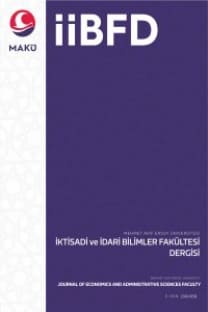BITCOIN FİYATLARINDA EŞİK DEĞER ETKİSİ
Bu çalışma, Bitcoin’in fiyat davranışını otoregresif birim kökü olan iki rejimli bir TAR modeli kullanarak araştırmaktadır. Çalışmada, durağan dışılığı ve doğrusal olmamayı eş zamanlı olarak sınayan Caner ve Hansen (2001) tarafından geliştirilen yöntem kullanılmıştır. Bu amaçla, 16.07.2010 – 27.11.2018 dönemi için (3.056 adet günlük gözlem) Bitcoin kapanış fiyatlarına ait veri seti oluşturularak Bitcoin fiyatlarının etkin olup olmadığı incelenmiştir. Elde edilen bulgular, Bitcoin fiyatlarının tüm dönem dikkate alındığında zayıf formda etkin piyasalar hipotezini desteklemektedir. Ancak rejimler arası geçiş dikkate alındığında Bitcoin fiyat serisinde iki rejim olduğu sonucuna ulaşılmıştır. Birinci rejimde zayıf forma etkin piyasalar hipotezinin geçerli olduğu, ancak ikinci rejimde geçerli olmadığı tespit edilmiştir.
Anahtar Kelimeler:
Bitcoin, Eşik Değer, TAR Model;, Etkin Piyasalar Hipotezi
THRESHOLD EFFECT IN BITCOIN PRICES
This study investigates the price behavior of Bitcoin using a two-regime TAR model, which is an autoregressive unit root. In the study, the method developed by Caner and Hansen (2001) was used which simultaneously tested non-stationary and non-linearity. For this purpose, the data set of Bitcoin closing prices for 16.07.2010 - 27.11.2018 period (3.056 daily observations) has been created to determine whether Bitcoin prices are efficient or not. The findings support the hypothesis that Bitcoin prices are efficient in weak form for the whole period. However, considering the switching between the regimes, it was concluded that there are two regimes in the Bitcoin price series. In the first regime, the hypothesis of efficient markets in the weak form is valid, but not in the second regime.
Keywords:
Bitcoin, Threshold Value;, TAR Model, Efficient Market Hypothesis,
___
- AL-YAHYAEE, K. H., MENSI, W., YOON, S. M. (2018), Efficiency, multifractality, and the long-memory property of the Bitcoin market: A comparative analysis with stock, currency, and gold markets. Finance Research Letters, 27, 228-234.
- ALMUDHAF, F. (2018), Pricing efficiency of Bitcoin trusts. Applied Economics Letters, 25(7), 504-508.
- ARDIA, D., BLUTEAU, K., RUEDE, M. (2019), Regime changes in Bitcoin GARCH volatility dynamics. Finance Research Letters, 29, 266-271.
- AYSAN, A. F., DEMİR, E., GÖZGÖR, G., LAU, C. K. M. (2019), Effects of the geopolitical risks on Bitcoin returns and volatility. Research in International Business and Finance, 47, 511-518.
- BAEK, C., ELBECK, M. (2015), Bitcoins as an Investment or Speculative Vehicle? A first look. Applied Economics Letters, 22(1), 30-34.
- BALCILAR, M., BOURI, E., GUPTA, R., ROUBAUD, D. (2017), Can volume predict Bitcoin returns and volatility? A quantiles-based approach. Economic Modelling, 64, 74-81.
- BARIVIERA, A. F. (2017), The inefficiency of Bitcoin revisited: A dynamic approach. Economics Letters, 161, 1-4.
- BRANDVOLD, M., MOLNÁR, P., VAGSTAD, K.,VALSTAD, O. C. A. (2015), Price discovery on Bitcoin exchanges. Journal of International Financial Markets, Institutions and Money, 36, 18-35.
- CANER, M., HANSEN, B. E. (2001), Threshold autoregression with a unit Root. Econometrica, 69(6), 1555-1596.
- CAPORALE, G. M., GIL-ALANA, L., PLASTUN, A. (2018), Persistence in the cryptocurrency market. Research in International Business and Finance, 46, 141-148.
- CHARLES, A., DARNÉ, O. (2018), Volatility estimation for bitcoin: Replication and extension. International Economics.
- CHEAH, E. T., FRY, J. (2015), Speculative bubbles in Bitcoin markets? An empirical investigation into the fundamental value of Bitcoin. Economics Letters, 130, 32-36.
- CHEUNG, A., ROCA, E., SU, J. J. (2015), Crypto-currency bubbles: an application of the Phillips–Shi–Yu (2013) methodology on Mt. Gox bitcoin prices. Applied Economics, 47(23), 2348-2358.
- CIAIAN, P., RAJCANIOVA, M., KANCS, D. A. (2016), The economics of BitCoin price formation. Applied Economics, 48(19), 1799-1815.
- CORBET, S., LUCEY, B., YAROVAYA, L. (2018), Datestamping the Bitcoin and Ethereum bubbles. Finance Research Letters, 26, 81-88.
- DEMİR, E., GÖZGÖR, G., LAU, C. K. M.,VIGNE, S. A. (2018), Does economic policy uncertainty predict the Bitcoin returns? An empirical investigation. Finance Research Letters, 26, 145-149.
- DYHRBERG, A. H. (2016), Bitcoin, gold and the dollar–A GARCH volatility analysis. Finance Research Letters, 16, 85-92.
- DWYER, G. P. (2015), The economics of Bitcoin and similar private digital currencies. Journal of Financial Stability, 17, 81-91.
- FAMA, E. F. (1970), Efficient capital markets: A review of theory and empirical work. The journal of Finance, 25(2), 383-417.
- HANSEN, B. (1999), Testing for linearity. Journal of economic surveys, 13(5), 551-576.
- HONG, K. (2017), Bitcoin as an Alternative Investment Vehicle. Information Technology and Management, 18(4), 265-275.
- JIANG, Y., NIE, H.,RUAN, W. (2018), Time-varying long-term memory in Bitcoin market. Finance Research Letters, 25, 280-284.
- KOÇOĞLU, Ş., ÇEVİK, Y. E., TANRIÖVEN, C. (2016). Bitcoin piyasalarının etkinliği, likiditesi ve oynaklığı. İşletme Araştırmaları Dergisi, 8(2), 77-97.
- KRISTOUFEK, L. (2018), On Bitcoin markets (in) efficiency and its evolution. Physica A: Statistical Mechanics and its Applications, 503, 257-262.
- NADARAJAH, S., CHU, J. (2017), On the inefficiency of Bitcoin. Economics Letters, 150, 6-9.
- PANAGIOTIDIS, T., STENGOS, T., VRAVOSINOS, O. (2018), On the determinants of bitcoin returns: A LASSO approach. Finance Research Letters, 27, 235-240.
- PHILLIP, A., CHAN, J. S., PEIRIS, S. (2018), A new look at Cryptocurrencies. Economics Letters, 163, 6-9.
- ŞENSOY, A. (2019), The inefficiency of Bitcoin revisited: A high-frequency analysis with alternative currencies. Finance Research Letters, 28, 68-73.
- TIWARI, A. K., JANA, R. K., DAS, D., ROUBAUD, D. (2018), Informational efficiency of Bitcoin—An extension. Economics Letters, 163, 106-109.
- URQUHART, A. (2016), The inefficiency of Bitcoin. Economics Letters, 148, 80-82.
- URQUHART, A. (2017), Price clustering in Bitcoin. Economics letters, 159, 145-148.
- VIDAL-TOMÁS, D., IBAÑEZ, A. (2018), Semi-strong efficiency of Bitcoin. Finance Research Letters, 27, 259-265.
- ISSN: 2149-1658
- Yayın Aralığı: Yılda 3 Sayı
- Yayıncı: Mehmet Akif Ersoy Üniversitesi İktisadi ve İdari Bilimler Fakültesi
Sayıdaki Diğer Makaleler
BÜYÜKŞEHİR İLÇELERİNDEKİ BELEDİYE MECLİS ÜYELERİNİN PROFİLİ ÜZERİNE BİR ARAŞTIRMA: TRABZON ÖRNEĞİ
Çağrı D. ÇOLAK, Y. Orçun KÜÇÜKYILMAZ
YÖNETİCİLERİN İŞLETME ENFORMASYON İHTİYAÇLARI İÇİN TERCİH ETTİKLERİ KAYNAKLAR
İsmail ÇELİK, Hilmi Tunahan AKKUŞ, Nazlıgül GÜLCAN
İlhan EGE, Tuğba NUR TOPALOĞLU
BITCOIN FİYATLARINDA EŞİK DEĞER ETKİSİ
BİLGİ EKONOMİSİ VE EKONOMİK PERFORMANS: TÜRKİYE VE AVRUPA BİRLİĞİ KARŞILAŞTIRMASI
Hasan Önder SARIDOĞAN, Muhammed Veysel KAYA
YÜKSEK TEKNOLOJİLİ ÜRÜN İHRACATI VE EKONOMİK BÜYÜME İLİŞKİSİ: TÜRKİYE ÖRNEĞİ
